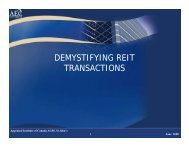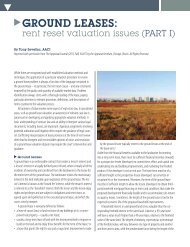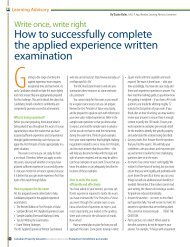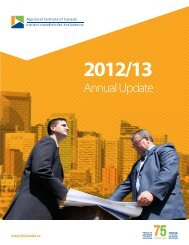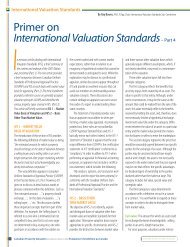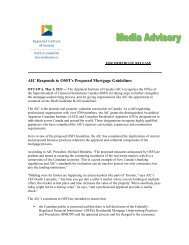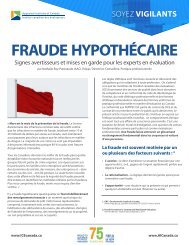Book 1 - Appraisal Institute of Canada
Book 1 - Appraisal Institute of Canada
Book 1 - Appraisal Institute of Canada
Create successful ePaper yourself
Turn your PDF publications into a flip-book with our unique Google optimized e-Paper software.
By definition, asset rationalization reduces the risk <strong>of</strong> improperacquisition.Some owners see real estate as an investment, while others use realproperty for their own benefit and are interested in preserving the value<strong>of</strong> their investment. Most institutional and corporate investors have welldefined, written goals in the form <strong>of</strong> policy statements or investmentguidelines that are readily obtainable from their website. An example isBrookfield Properties 4 which “is committed to building shareholder value byinvesting in premier quality <strong>of</strong>fice assets and pro-actively managing each <strong>of</strong>our properties to increase cash flows and maximize return on capital.” Froma public perspective, the City <strong>of</strong> Ottawa is strategically driven to optimizethe value <strong>of</strong> city-owned property holdings based on balancing the City’sfinancial, social, cultural, and environmental objectives for these holdings.PlanningAs John McMahan states in his book The Handbook <strong>of</strong> Commercial RealEstate Investing 5 , the role <strong>of</strong> the asset manager has evolved over thelast 50 years, as real estate has gone from individual to institutionalownership and from the management <strong>of</strong> a few properties in a singlemarket to large portfolios located in <strong>of</strong>ten dispersed geographical areas.The modern real estate asset manager is a multi-disciplined, highlytrainedreal estate pr<strong>of</strong>essional who is expected to not only be responsiblefor managing investment assets during the investment holding period,but be an integral part <strong>of</strong> both the acquisition and disposition process.Below is a list <strong>of</strong> potential objectives for the asset manager as itapplies to strategic asset management:• support <strong>of</strong> corporate objectives, e.g., the four pillars approach (financial,social, cultural and environmental) through redevelopment or otherinitiatives;• implementation <strong>of</strong> asset management strategies for all owned andleased facilities;• provision <strong>of</strong> strategic portfolio planning and expert real estate advice toits ownership to ensure that their real estate needs are met in the mostefficient and effective manner;• generation <strong>of</strong> development strategies with intent to maximize the value<strong>of</strong> corporate real property holdings;• development <strong>of</strong> effective property solution options for ownership thatsupport a balanced and affordable solution;• determination <strong>of</strong> the suitability and affordability <strong>of</strong> the portfolio tomeet the needs <strong>of</strong> all client groups;• development <strong>of</strong> value-added real estate solutions for core andnon-core assets;• development <strong>of</strong> facility and portfolio plans which recommend thedisposition, remediation, redevelopment, retirement and/or retention<strong>of</strong>, and reinvestment in, those properties which are demonstrablysustainable, affordable and appropriately utilized; and• analysis, rationalization, demonstration and communication <strong>of</strong> theaccurate whole-life cost implications <strong>of</strong> real property solutions orpolicies that are introduced in response to the needs <strong>of</strong> clients.AcquisitionThe decision to purchase/lease real estate is found within the owner’sobjectives. Some potential scenarios include:• purchase <strong>of</strong> an existing property;• purchase <strong>of</strong> a vacant site for development;• redevelopment <strong>of</strong> an existing property; or• lease.With any acquisition, the buyer and seller ultimately enter into a Purchaseand Sale Agreement (P & S Agreement). However, in some instances, aLetter <strong>of</strong> Intent may be prepared prior to this stage to outline the potentialbusiness terms. The P & S Agreement serves as a legal contract betweenthe two parties and forms the basis for how the purchaser will obtaincontrol <strong>of</strong> a property.With the purchase <strong>of</strong> real property, proper due diligence must becarried out. Due diligence is the process <strong>of</strong> investigating and verifyinginformation as it pertains to the subject property. Typically, this processstarts before an <strong>of</strong>fer is made. However, once an <strong>of</strong>fer is made, it typicallyincludes clauses that allow completion <strong>of</strong> further due diligence suchas: title search, environmental investigation, building condition audit,designated substance pr<strong>of</strong>iling, engineering and structural reviews, etc.The amount <strong>of</strong> time that a purchaser needs to satisfy due diligencerequirements is a critical part <strong>of</strong> the negotiation process. Clearly, thetransaction cannot close until the due diligence process has beencompleted.Due diligence for a vacant parcel <strong>of</strong> land might include confirmation<strong>of</strong> zoning, <strong>of</strong>ficial plan designation, satisfactory financing, obtaining anappraisal, title search, assessment <strong>of</strong> environmental issues, review <strong>of</strong>survey plan, consultation with the local municipality, determination <strong>of</strong>geotechnical condition <strong>of</strong> soil, private/municipal services, accessibility,review <strong>of</strong> future development in the area, development charges, <strong>of</strong>f-siteobligations, archaeological issues, wetland concerns, etc.Similarly, the due diligence process for an improved property mightinclude the above as well as a building condition audit; and review <strong>of</strong>:life cycle costs, historical operating costs, environmental issues withinclick here to return to table <strong>of</strong> contentsCanadian Property Valuation Volume 54 | book 1 | 2010 Évaluation Immobilière au <strong>Canada</strong> 43



